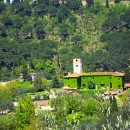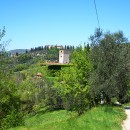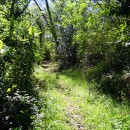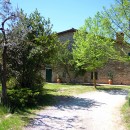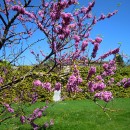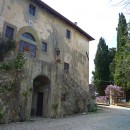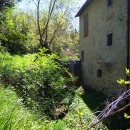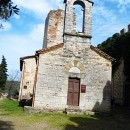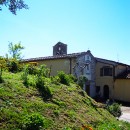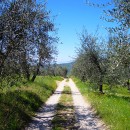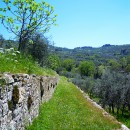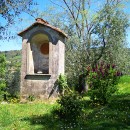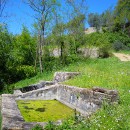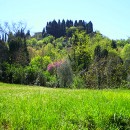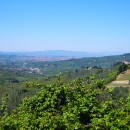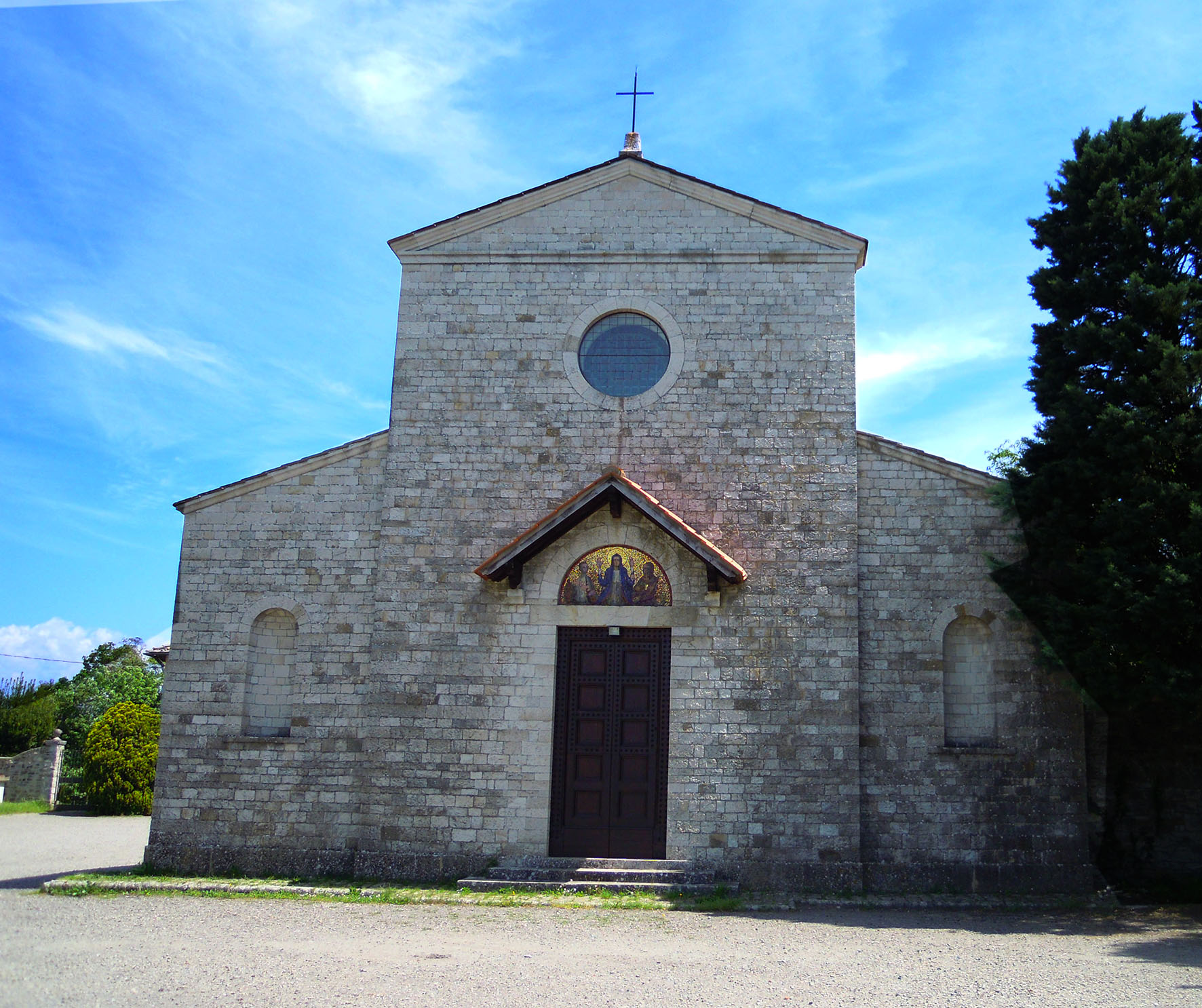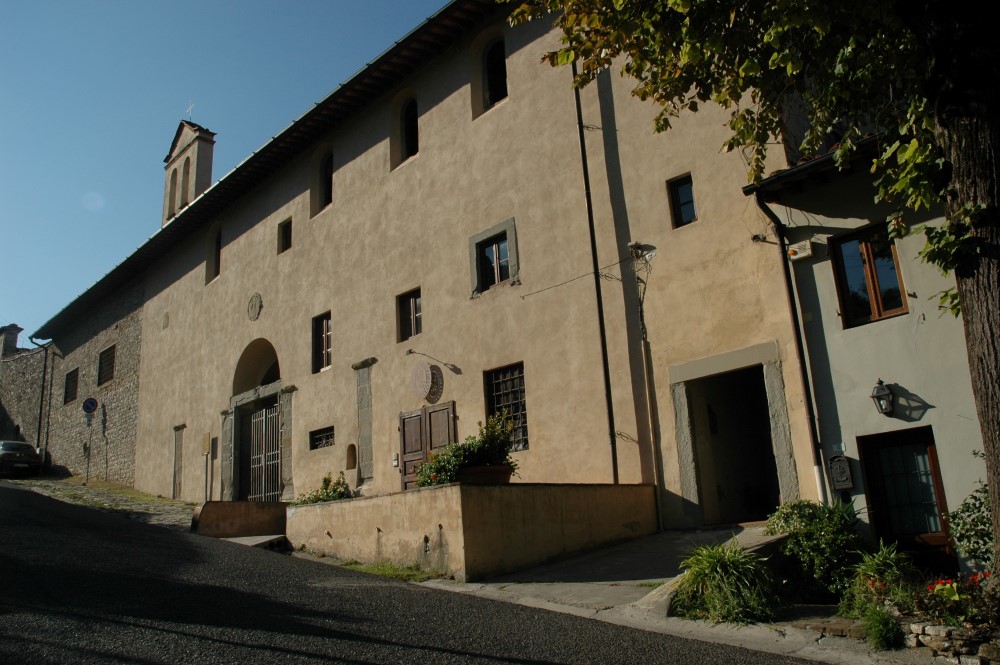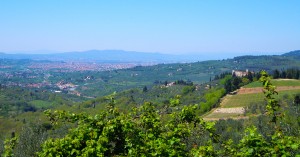
Difficulty: easy / medium – length: 9 km – Time: 2 hours 45 minutes – 380 calories
In this beautiful excursion, we will discover ancient medieval castles, built in defense of the roads between the plain of Florence and the upper Valdarno.
From Bagno a Ripoli, we take Via di Rosano in the direction of Pontassieve and then turn at the signpost which indicates Case San Romolo, going along the beautiful wooded road. After approximately 2.5 km of bends, we come to the Monte Acuto castle, where we can park in a stopping place at the beginning of the dirt road. Here begins our excursion, which I recommend be done with shoes and comfortable clothing given that in some places the paths are poorly tracked.
Monte Acuto castle is private, but it’s worth walking around to observe the mighty fortalice structure with the characteristic crenellated tower, in the shadow of which we can find the small chapel dedicated to St. James. From the square in front, you can enjoy a magnificent view, which ranges from cultivated hills to the plain of Florence.
We continue on foot to the village of Case San Romolo, beyond which as we walk we can see the image of an area very similar to what we would have seen here at the beginning of the fifteenth century: open country, intensively cultivated and arable with lines of trees, the result of the work of sharecroppers who lived on the farms of wealthy Florentine merchants, owners of the “noble houses” which, along with castles and towers, make this unique landscape.
When we see the small bell tower of San Romolo stick out over a flowery garden, we leave the paved road to follow the arrow that points towards the simple country church, perfectly integrated into the farmhouse of this farm.
We continue along the path between the garden and the church to return to Via di San Romolo, which we leave at the sign for Turrita to go into sunny countryside. The dirt road marked by rows of vines leads to a farmhouse that helps us identify the lane on the left which, through the terraces of an olive grove, leads us to discover an old washhouse.
Interesting fact
It is probably the basin referred to by the popular saying that “attributes three wonders to Villamagna: a basin on top of a hill; an olive tree that made a barrel of oil a year and a saint in the middle of a bunch of thieves.” 1
The saint is the Beato Gherardo (Blessed Gerard).
Here begins the more rugged* part of the excursion, we enter into the bush and then find ourselves immersed in the green of a clearing, which the light of the clear spring days makes even more brilliant. If we raise our eyes above us, hidden among the cypresses, we find Villa il Poggio, our next destination.
Accompanied by the flow of water, given that we are on the trail of the ancient route of the mills, we walk along the edge of the woods to find the path that leads to the mill of Villamagna. Although nowadays it is a private home, it still retains all the charm of a timeless place: an atmosphere that we can sense sitting on the wall of the bridge before continuing along the path we find in front of us. Once we arrive in front of the high walls that hide the Villa il Poggio Italian garden, we skirt along them on the right-hand side to better observe beyond the gate. So far, we have traveled about 3 km.
In ancient sources, Villa il Poggio is remembered as one of the most flourishing “palace”-villas of the Villamagna countryside. Originally owned by the Cavalcanti, it then had various owners who have, over time, contributed to its sixteenth-century appearance, until in 1674 it was sold to Count Francesco Del Benino. The main embellishments and enlargements both to the building and to the surrounding agricultural property date back to this period. 2
Let’s stop and look around, indeed, the property is beautiful. We travel a stretch of it, taking the local road running through the fields, protected by the unavoidable tabernacle, until we return to the bush, where a stone that says “Mulino di Piccia” shows us the path to be taken to go back in time, to the medieval Castel Belforte. Within walking distance and in the center of the valley, we the castle tower rising up, which is the oldest core of the entire complex. On the hill to the right, we see the Castel Monte Acuto fortalice again: in a striking position today but, at the time, strategic for control of the valley.
These castles are among the oldest examples of medieval architecture in the Bagno a Ripoli area.3 Today they are private homes, but are nonetheless still impressive in the context of this intact landscape. Depending on where are, we can also see the battlements of the Torre delle Nutrici and those of the beautiful Torre di Rignalla.
We retrace our steps to Villa il Poggio and skirt the wall again until we cross Via del Mulino di Villamagna. Next to the tabernacle of this road, there are stairs that lead to a field with olive trees, under whose shade we can rest before turning left into Via di San Romolo. In about 30 minutes, we will have returned to our departure point.
*Note
To arrive directly to Villa il Poggio, whomever wants a more comfortable excursion can continue along Via San Romolo and turn right after about 1.5 km, in the Via del Mulino di Villamagna.
1)Fra terra e cielo (Between the Earth and Sky) – Silvano Guerrini
2)www.wikipedia.org
3) (G.B. Ravenni, “Fuori presso alle mura della città” (Away at the city walls) in Senza fretta, guide per attenti viaggiatori del pianeta (Without a hurry, guides for alert planet travellers), Bagno a Ripoli, Editoriale Tosca srl, Firenze)


